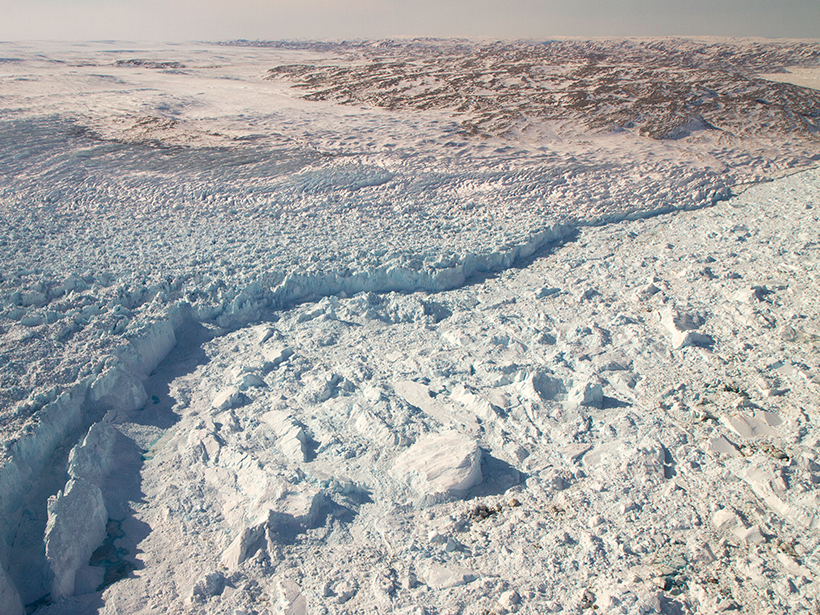As the Greenland ice sheet creaks and cracks, scientists are listening.
Since the 1990s, researchers have seen a rise in the number of glacial earthquakes emanating from Greenland’s glaciers—earthquakes that stem from massive blocks of ice calving from glacier fronts. Nearly half of the glacial earthquakes in the past quarter century occurred between 2011 and 2013, a team of researchers has now found after digging through seismic data. These earthquakes could be a signal of a warming climate’s effect on the stability of the ice sheet itself.
“The rise in glacial earthquakes is part of the larger pattern of ice loss that is happening all over the Greenland ice sheet.”
“The rise in glacial earthquakes is part of the larger pattern of ice loss that is happening all over the Greenland ice sheet,” said Kira Olsen, a Ph.D. candidate at Columbia University in New York, who led the new study. Along with recorded ice loss and melt runoff, more frequent glacial earthquakes are “another piece of evidence that Greenland is rapidly losing ice.”
Olsen presented the research at a poster session on 14 December at the 2016 Fall Meeting of the American Geophysical Union in San Francisco, Calif.
Shaking Ice
The Greenland ice sheet is a slab of ice that covers more than 1 million square kilometers and stands 3 kilometers thick in some places. Over years and years, snow has accumulated and compacted into the hard ice that built up the slab, which spreads out under its own weight. As glaciers flow through Greenland’s fjords, their leading edges often extend out onto the sea as an ice shelf. Blocks of ice that calve off these floating ice shelves may produce small seismic signals, but these aren’t the signals the scientists were studying.
Olsen and her colleagues focused instead on calving from glaciers that end where the land and ocean meet. In those events, gigantic blocks of ice, typically with a mass of about a gigaton (1 gigaton equals 1 billion metric tons), break free and produce glacial earthquakes that generally register magnitude 5 on seismometers as far away as New York or the Midwest in the United States. A gigaton of ice would fill Central Park in New York as high as the top of the Empire State Building, Olsen said.
When two slabs of Earth’s crust push past each other, they can cause the ground to shake for as long as tens of seconds. Olsen noted that glacial earthquakes, on the other hand, can last up to a minute and produce longer wavelengths than ordinary earthquakes, so they can be picked out of seismic data.
Two years ago, Olsen’s adviser Meredith Nettles and a team of researchers studied the mechanisms behind glacial earthquakes. In that study, they detailed what happened when huge blocks of ice calved from the end of a glacier grounded on land. The tall, thin block of glacier—like a slice of bread—breaks off at the bottom of the glacier and rotates outward. Such calving action, like the example in this video from 2010, sends seismic signals careening through the Earth.

Olsen’s research focused on the frequencies and locations of these earthquakes, and it examined seismic data for many glaciers stretching back to 1993, which is the earliest year on record for glacial quakes in Greenland, and zoomed in specifically on 2011–2013, the most recently compiled data.
Recent Surge in Quake Numbers
Olsen and her colleagues found that the annual tally of earthquakes increased significantly between 1993 and 2011, from about 10 quakes per year initially to about 40 quakes per year most recently. Moreover, of the 305 glacial earthquakes in total that have struck the Greenland ice sheet since 1993, 145 of them, or nearly half, occurred from 2011 to 2013.
Furthermore, the researchers found that two of the quakes had taken place at a glacier called Sermeq Silardleq, which had never before sustained a glacial earthquake.
The jump in glacial quake frequency is worrisome, Olsen said, because “it is evidence that more of these gigaton-size icebergs are calving from glaciers every year.” The fact that researchers see more earthquakes means that something—possibly global warming—is forcing the glaciers to retreat, she continued.
Greenland’s Ice Loss
If the whole Greenland ice sheet melted at once, sea level would rise 7 meters globally.
Currently, scientists estimate that Greenland’s ice sheet loses between 300 and 400 gigatons of ice per year. That loss causes only a tiny sea level rise around the world, but if the whole Greenland ice sheet melted at once, sea level would rise 7 meters globally. Even a 2-meter rise from melting of the Greenland and Antarctic ice sheets, an amount some scientists say could happen by the end of 2100, would devastate coastal cities around the world.
Studying glacial earthquakes, which reveals processes by which Greenland loses ice, provides important insights into how quickly Greenland’s ice sheet could shrink in the future, said Richard Alley, a glaciologist at Pennsylvania State University in University Park, who wasn’t involved in the research.
“We worry that in the future, iceberg calving from nonfloating ice could go even faster, raising sea level faster,” he said.
—JoAnna Wendel (@JoAnnaScience), Staff Writer
Citation:
Wendel, J. (2017), More frequent glacial quakes on Greenland signal ice retreat, Eos, 98, https://doi.org/10.1029/2017EO065855. Published on 05 January 2017.
Text © 2017. The authors. CC BY-NC-ND 3.0
Except where otherwise noted, images are subject to copyright. Any reuse without express permission from the copyright owner is prohibited.

